How to Make Hydrangeas Purple Naturally: Simple Gardening Tips
Are you dreaming of vibrant purple hydrangeas in your garden? You’re in luck, because turning hydrangeas purple is quite achievable with a few natural methods. The secret lies in altering the soil pH around your plants. By adjusting the soil to a slightly acidic level, between 5.0 and 6.0, you can encourage the beautiful purple hues to appear in your hydrangea flowers.
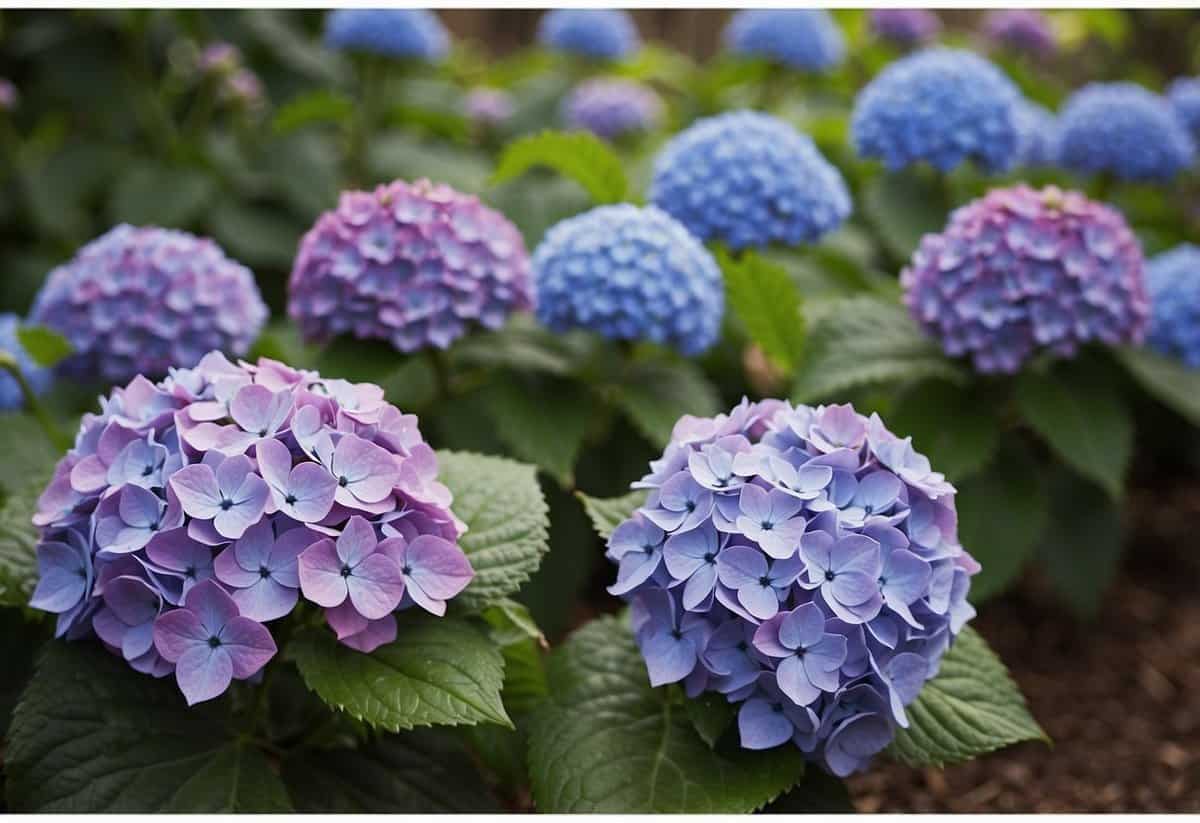
You can start by mixing ground lime into the soil, which helps raise the pH level. Adding a cup of lime mixed with water around the roots of your hydrangeas ensures they absorb less aluminum, leading to more purple blooms. Coffee grounds are another natural way to tweak the soil pH. These grounds are acidic and can gently lower the pH when worked into the soil around the plant.
Additionally, good garden care plays a crucial role. Providing your hydrangeas with morning sunlight and ample water will help them thrive and show off that desired color. Happy gardening, and enjoy those gorgeous purple blossoms!
Understanding Soil pH and Hydrangea Color

To make hydrangeas purple, you must understand the relationship between soil pH and flower color. This section explains how soil pH affects hydrangea color and how you can adjust your garden’s pH level to achieve the desired hue.
The Role of Soil pH in Flower Color
Soil pH is key to changing hydrangea colors. The pH level measures how acidic or alkaline your soil is, which directly influences whether hydrangea flowers are blue, pink, or purple.
Hydrangeas in acidic soil (pH below 6.0) often produce blue flowers. In more alkaline soil (pH above 6.5), they tend to have pink flowers. For purple blooms, you need a pH level between 5.5 and 6.5.
Maintaining a slightly acidic to neutral pH allows the complex colorations needed for purple flowers. Through careful adjustments, you can find the perfect balance for your hydrangeas’ colors.
Adjusting Your Garden’s pH Level
To adjust your garden’s pH, first test the current level using a soil pH test kit. These are widely available at garden centers. If the soil is too acidic, add garden lime to increase the pH. Mixing in lime slowly raises the pH and makes your soil less acidic.
If your soil is too alkaline, use substances like sulfur or aluminum sulfate to lower the pH. Adding these materials lowers the pH and increases soil acidity. Regularly recheck the pH levels to maintain the balance needed for purple hydrangeas.
Watering consistently, especially in the morning, and ensuring good soil drainage also help maintain the proper pH levels. This steady environment supports healthy, vibrant purple blooms.
Altering Soil Composition
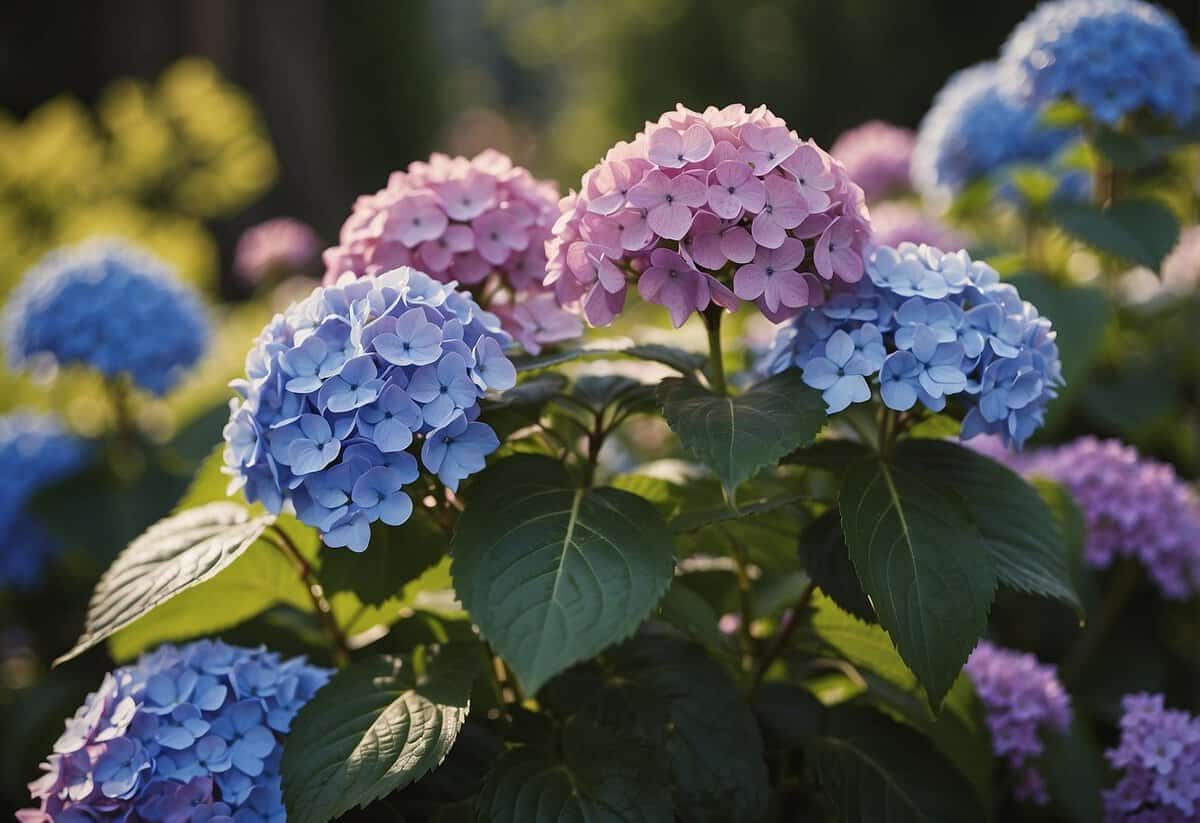
To achieve purple hydrangeas, it’s essential to modify your soil composition effectively. Key approaches include introducing aluminum to promote purple tones and using organic amendments to acidify the soil.
Incorporating Aluminum for Purple Tones
Adding aluminum can help create the desired purple color in hydrangea blooms. Aluminum sulfate is a popular choice for this purpose. Dissolve one tablespoon of aluminum sulfate in a gallon of water and apply it to the soil around your hydrangeas. Be careful not to overuse it to avoid damaging the plants.
Regular soil tests are vital to monitor the aluminum levels and ensure they are optimal. Too much aluminum can be harmful, so balance is crucial. It’s also important to maintain a soil pH level of around 5.0 to 6.0, as this enhances the plant’s ability to absorb aluminum.
Organic Amendments for Acidifying Soil
Using organic material is another effective method to alter soil acidity. Peat moss, pine needles, and fruit peels can help lower soil pH naturally. Incorporate these materials into your garden soil to gradually make it more acidic.
Coffee grounds and compost also work well. Spread a layer of these organic materials around the base of your hydrangeas. You can also use vinegar to acidify the soil. Mix one cup of vinegar with a gallon of water and pour it around the plant base.
Supplementing with elemental sulfur is another strategy. This can lower the soil pH over time, helping maintain the desired acidity. Regular additions of organic mulch can help retain moisture and enrich the soil, supporting healthier hydrangea growth.
Proper Fertilization Techniques
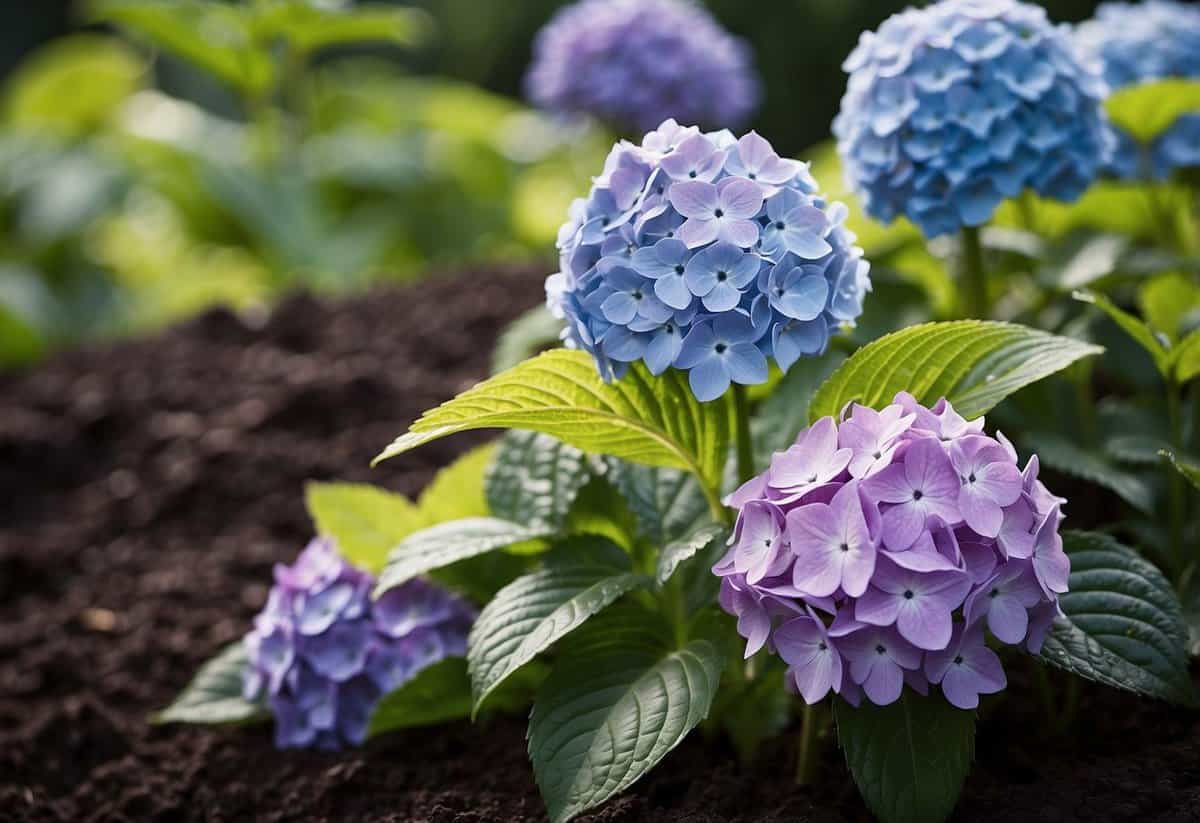
To make hydrangeas purple, choosing the right fertilizer is crucial. Balancing nutrients and maintaining the correct soil pH will help achieve the desired color.
Choosing the Right Fertilizer
Using fertilizers made specifically for hydrangeas can be beneficial. Look for products containing aluminum sulfate, which helps the plant absorb aluminum—a key factor in color changes. Espoma offers such fertilizers.
Slow-release fertilizers work well as they provide a constant supply of nutrients. Choose a blend with a balanced mix of nitrogen, phosphorus, and potassium (N-P-K), as these elements support overall plant health.
Banana peels can be used as a natural fertilizer. Dry and grind them, then sprinkle around the plant. They slowly release nutrients into the soil. Regular fertilization, combined with correct pH and watering, can make your hydrangeas turn purple and thrive.
Balancing Nutrients for Optimal Color
To achieve the best purple hue, maintaining the right balance of nutrients in the soil is essential. Hydrangeas need an acidic to slightly acidic soil with a pH between 5.0 to 6.0.
Add garden lime if your soil is too acidic. This helps raise the pH level, preventing the hydrangeas from turning blue. Conversely, using garden sulfur can lower the pH if soil is too alkaline.
Aluminum sulfate can be applied to promote the absorption of aluminum, influencing the purple coloration. Avoid over-fertilizing with nitrogen, as it can lead to excessive green growth at the expense of flowers.
Monitor the soil pH regularly and adjust fertilization practices accordingly to maintain optimal nutrient levels and achieve beautiful purple hydrangeas.
Care and Maintenance for Purple Hydrangeas
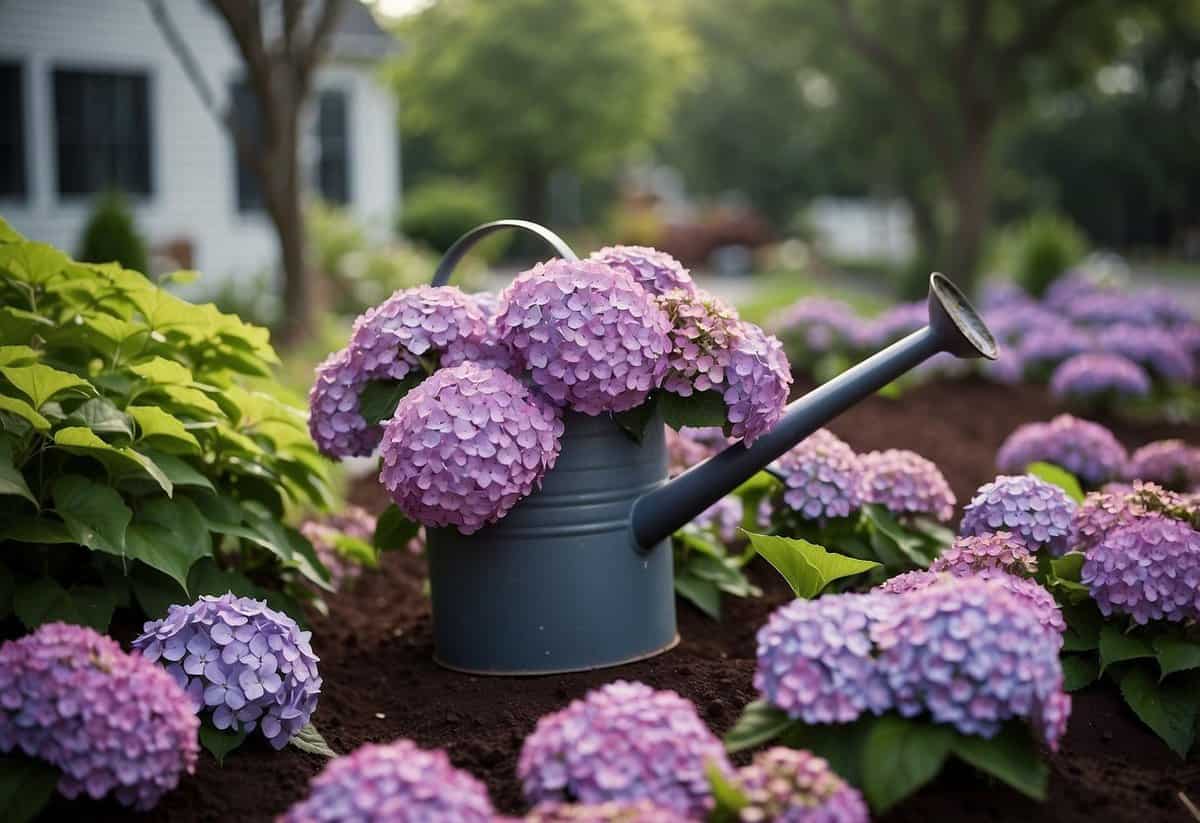
To keep your hydrangeas blooming with vibrant purple flowers, focus on proper pruning, watering, and maintaining the right soil pH.
Seasonal Pruning and Watering
Pruning is essential for maintaining the health and beauty of your hydrangea bush. For varieties like hydrangea macrophylla and Endless Summer, prune in late winter or early spring. Remove any dead or weak stems to promote strong, healthy growth.
Keep an eye on your mountain hydrangea (hydrangea serrata) as well. Prune lightly to avoid cutting off flower buds. Avoid heavy pruning, especially after mid-summer, as it can reduce the number of blooms.
Proper watering is crucial. Hydrangeas prefer consistent moisture, especially during hot, dry periods. Water deeply once a week, ensuring the soil remains damp but not waterlogged. Mulch around the base to retain moisture and reduce weeds.
Monitoring and Adjusting Soil pH
To achieve those stunning purple hues, monitor your soil pH. Hydrangeas need slightly acidic to neutral soil for purple blooms. A simple soil pH test kit can help you check this.
If your soil is too acidic, add dolomitic lime to raise the pH. For alkaline soil, lower the pH by adding sulfur or aluminum sulfate. Hydrangeas like Endless Summer respond well to these adjustments.
Consistent pH levels are key. Regularly test and adjust as needed to keep your hydrangea varieties happy. Proper soil management allows for vibrant color changes, ensuring your flowers maintain their beautiful purple shade year after year.
Troubleshooting Common Issues
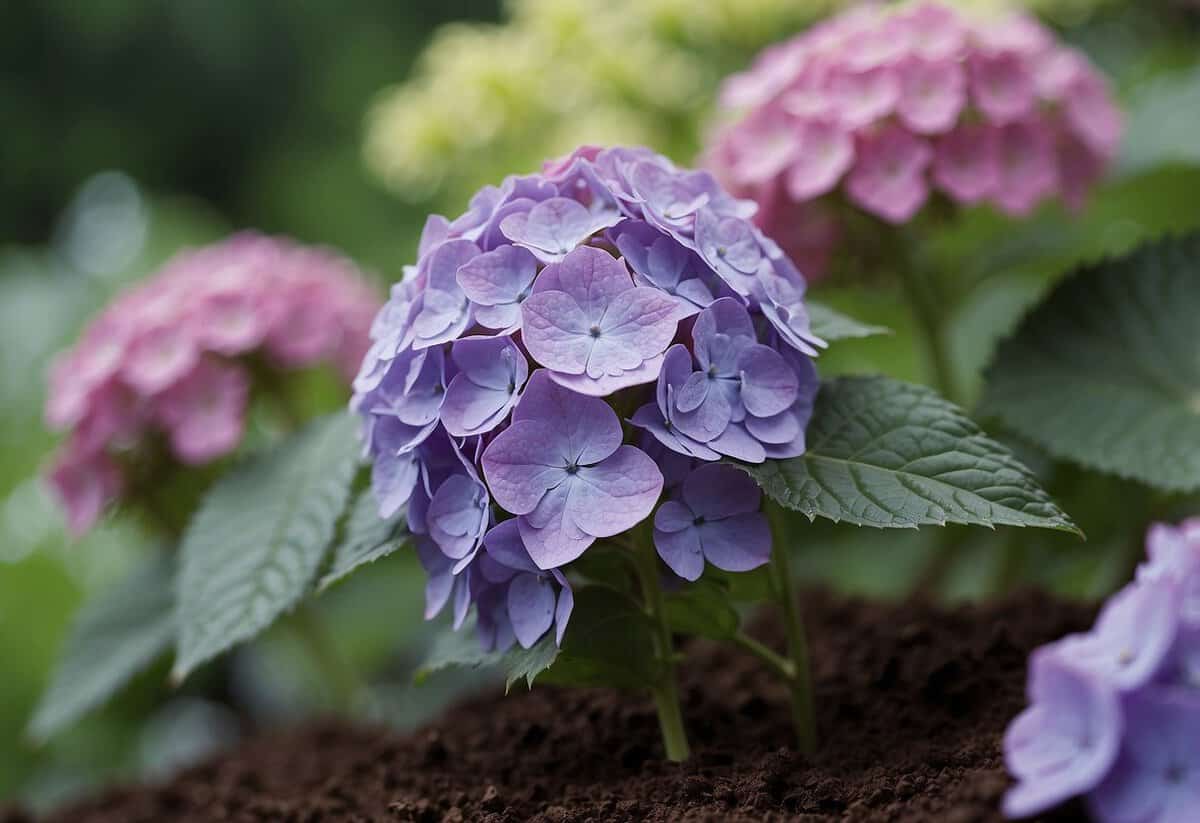
When making hydrangeas purple, you might face some issues, such as color fading and weak stems, or problems with soil pH and nutrients. Here are some tips to help you address these challenges and keep your plants healthy and vibrant.
Addressing Color Fading and Weak Stems
If the blooms of your purple hydrangeas begin to fade or the stems appear weak, you need to take action. Color fading can be due to too much sun exposure. Bigleaf hydrangeas, including cultivars like Nikko Blue, prefer morning sunlight and afternoon shade to maintain their vibrant purple hues.
Weak stems can result from insufficient watering or lack of nutrients. Mountain hydrangeas often face this issue. Ensure the soil stays moist, especially during the growing season. MULCH can help retain moisture. Provide nutrient-rich compost or balanced fertilizer to support strong stem growth.
Another trick is to remove and compost lawn clippings around your hydrangeas to reduce competition for nutrients. Pruning older or damaged stems in early spring can also encourage stronger new growth and more colorful blooms.
Dealing with Incorrect pH and Nutrient Problems
Hydrangeas, especially mophead and bigleaf varieties, require specific soil conditions to turn purple. For blue flowers to change to vibrant purple, you need to adjust the soil pH. A pH between 5.5 to 6.5 is ideal.
To raise pH levels and decrease acidity, add ground lime or baking soda to your soil. If your blooms are more pink, this will help bring out purple tones. Apply the amendments in small amounts and test the soil regularly.
Conversely, for too neutral or slightly alkaline soils, use white vinegar or sulfur to lower the pH. This helps maintain those beautiful purple blooms. Be mindful that genetics also play a role; some hydrangeas, like certain panicle varieties, naturally resist color changes.
Nutrient balance is crucial. Iron and aluminum influence color changes. Ensure your plants get these through fertilizer or organic mulch. Regular checks and proper adjustments can keep your hydrangeas healthy and colorful.







